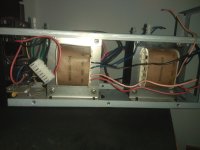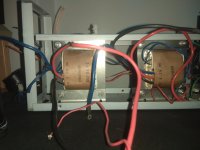Hi everyone,
i was given two cheap, but identical 650VA ups units with broken batteries.
While salvaging parts, it occured to me that i may be able to make an isolation transformer, using the two identical transformers back to back.
I know it won't be able to supply a lot of power, but i'am ok with around 100 VA, just to be able to scope mains stuff without blowing up everything. The transformers look like about 150 VA each.
Now, each primary has the following taps: 0V, 185V, 220V, 255V.
The secondaries read 7.1V, 0V, 7.1V (center tapped), and there is also a low power separete 19V winding.
I will use the casing of one of the units to enclose everything, as it already has a mains power cord and a convinient mains outlet, and even a fuse holder!
Any ideas how to wire them up for testing?
I suspect that i don't need the 0V center tap of the secondaries, and i should be carefull with the 19V secondary polarity.
Of course i'am going to test it with incandescent lamps of 25, 40, 60, and 100 Watts to see if the voltages and the temperatures are ok.
Any ideas greatly appreciated!
i was given two cheap, but identical 650VA ups units with broken batteries.
While salvaging parts, it occured to me that i may be able to make an isolation transformer, using the two identical transformers back to back.
I know it won't be able to supply a lot of power, but i'am ok with around 100 VA, just to be able to scope mains stuff without blowing up everything. The transformers look like about 150 VA each.
Now, each primary has the following taps: 0V, 185V, 220V, 255V.
The secondaries read 7.1V, 0V, 7.1V (center tapped), and there is also a low power separete 19V winding.
I will use the casing of one of the units to enclose everything, as it already has a mains power cord and a convinient mains outlet, and even a fuse holder!
Any ideas how to wire them up for testing?
I suspect that i don't need the 0V center tap of the secondaries, and i should be carefull with the 19V secondary polarity.
Of course i'am going to test it with incandescent lamps of 25, 40, 60, and 100 Watts to see if the voltages and the temperatures are ok.
Any ideas greatly appreciated!
Attachments
Mains here is 230 volts, so i guess i should use the 255V taps for input and output. Is this correct?
@Max, what kind of filtering are you suggesting? Maybe a common mode choke and/or a small filter cap?
Also, i guess that i should connect the outer 7.1V taps across the transformers, but what about the 0V taps. My guts tell me that i should leave them out of the equation...
@Max, what kind of filtering are you suggesting? Maybe a common mode choke and/or a small filter cap?
Also, i guess that i should connect the outer 7.1V taps across the transformers, but what about the 0V taps. My guts tell me that i should leave them out of the equation...
Ok, after testing with the 0-255V primaries on both transformers, i get 227 volts out when unloaded (vs 231 mains measured on the wall) but the voltage goes down to 217 volts when loaded with a 40 Watt bubl. I can probably live with that!
Edit: The voltage climbes to 219 volts under the 40 watt load, when connecting the 19 volt secondaries.
Edit: The voltage climbes to 219 volts under the 40 watt load, when connecting the 19 volt secondaries.
Last edited:
You have the penalty of twice the regulation, which explains the poor performance under load.
You should probably use the 220V tap at the input and the 255V one at the output.
The no-load voltage will be on the high side, but under load you'll get a more correct value
You should probably use the 220V tap at the input and the 255V one at the output.
The no-load voltage will be on the high side, but under load you'll get a more correct value
Thanks Elvee,
Now, using the 220V primary and 255V secondary, i get 264V out unloaded, which is high, but falls to 240 when loaded down by 40 watts. I will install a switch for the output secondary selection, which will give the best of both worlds. Probably an output volt meter would be nice too.
Now, using the 220V primary and 255V secondary, i get 264V out unloaded, which is high, but falls to 240 when loaded down by 40 watts. I will install a switch for the output secondary selection, which will give the best of both worlds. Probably an output volt meter would be nice too.
- Home
- Amplifiers
- Power Supplies
- Isolation transformer construction

